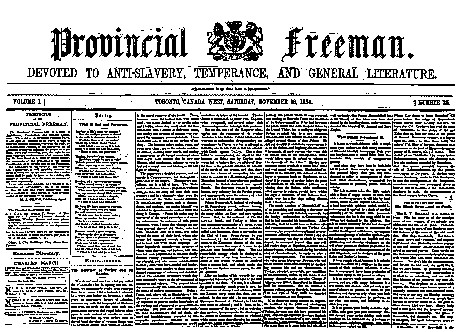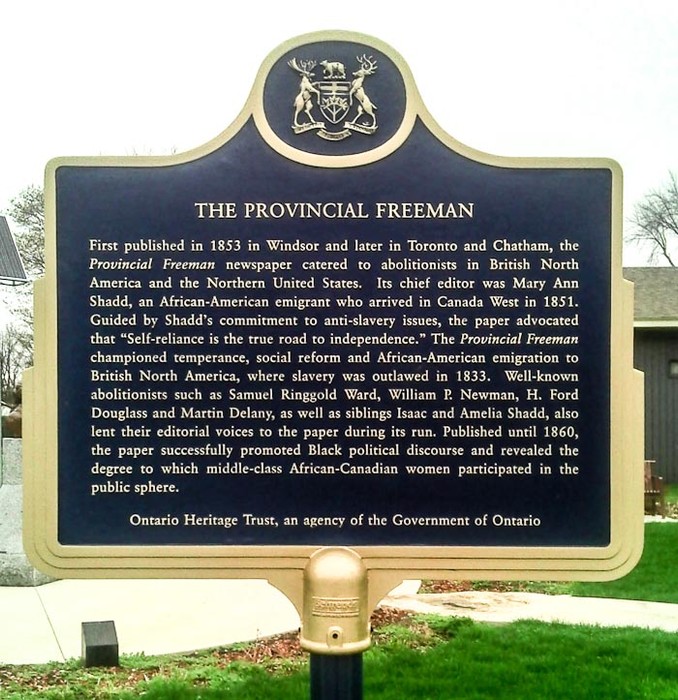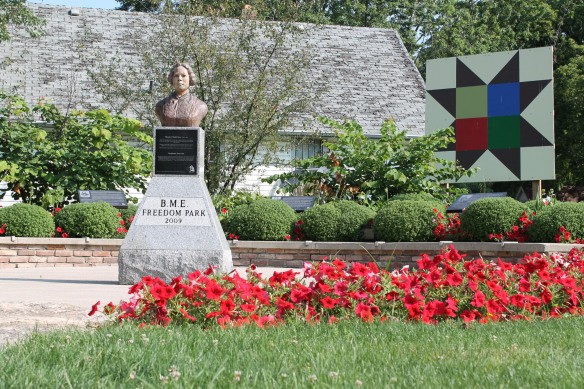The Provincial Freeman
Introduction
Text-to-speech Audio
Images
A Page from the Provincial Freeman

Mary Ann Shadd Cary

Plaque to Commemorate The Provincial Freeman

Statue of Mary Ann Shadd Cary

Backstory and Context
Text-to-speech Audio
The Provincial Freeman marked a cornerstone in the history of African-Americans/Canadians as well as women. Mary Ann Shadd Cary was one of the first African-American women in North America to publish or edit any publication. She was born in 1823 in a free African American family living in the slave state of Delaware. Shadd emigrated to Canada West in 1854. She began publication of the Provincial Freeman in Windsor. A year following its founding, it moved to Toronto. In July of 1855, it moved to Chatham, where it would remain for the rest of its existence. In the second issue of the paper, the exact intentions for the creations were outlined. It was said that there were thousands of people of colour that should have a journal catering to their interests. It was said that in order for people in America to make a choice to move to Canada, they should have information provided to them about what life was really like in Canada. There was a common narrative of Canada being a utopian safe-haven for anyone who was able to make the journey; however, Shadd noted that deeply held racist ideas were still prevalent within the country, and the paper believed that prospective emigres had the right to make an informed decision. She also argued for the free expression of ideas within Canada, and said that while racial prejudice was still prevalent, there was also "progress of the Negro in Canada." (1)
Shadd Cary did not struggle with just racism but also with misogyny and sexism. In his description of Shadd, Frederick Douglass wrote that "we do not know her equal among the coloured ladies of the United States. [She possesses] unceasing industry,... Unconquerable zeal and commendable ability... The tone of her paper has been, at times, harsh and complaining." (2) The author notes that there is a contradiction between respect and derision that he shows here. (3) When the paper first started, the decision was made to have a male editor be publicly announced. Samuel Ringgold Ward was officially the editor. Historians think that he was named this position because of his frequent contributions and his fame in the Black community. In this way, the paper would remain respectable in the eyes of the public. It would avoid comments like those by Douglass. Her contributions to the press did not go unnoticed, however. By 1855, the majority of letters were addressed "to the editeress of the Provincial Freeman." (4) In 1856, the editors were announced publicly to be three people, two of whom were male, one of whom being Mary Add Shadd Cary's brother Isaac. Shadd Cary provides a notable example of how women were able to exploit the expectation that women had a moral authority rightfully exercised in their families. By talking about issues of abolition and temperance, the Provincial Freeman accepted this authority of the female voice, but expanded its reach in the public sphere.
The Provincial Freeman ended in Chatham in 1858 in the wake of the events surrounding the "Demarest Rescue" and financial pressures on the Shadds.By the 1850s, Chatham was known for its thriving African American/African Canadian community and was dubbed the "Black Mecca." The Provincial Freeman was a vital part of the abolitionist culture of Chatham, and remains a rich source of evidence on Black women, first-wave feminism, and abolition in the Great Lakes region.
1 Alexander L. Murray "The Provincial Freeman: A New Source for the History of the Negro in Canada and the United States." The Journal of Negro History 44, no.2(1959):1232135, 126
2 Jane Rhodes. Mary Ann Shadd Cary: The Black Press and Protest in the 19th Century. Bloomington: Indiana University Press, 1998, xi
3 ibid.
4 Alexander L. Murray "The Provincial Freeman: A New Source for the History of the Negro in Canada and the United States." The Journal of Negro History 44, no.2 (1959):1232135, 125
Sources
Accessible Archives. Provincial Freeman. Malvern, PA: Accessible Archives.
Bearden, Jim and Linda Jean Butler. Shadd : The Life and Times of Mary Shadd Cary. Toronto: NC Press, 1977.
Bridgen, Lorene. "On their Own Terms: Temperance in Southern Ontario's Black Community." Ontario History 101, no. 1 (2009): 64.
CARY, MARY ANN SHADD, 1823-1893. papers of Mary Shadd Cary, Teacher, Black Spokesman and Editor of Provincial Freeman, Canada West, 1851-1889, 1823.
Murray, Alexander L. "The Provincial Freeman: A New Source for the History of the Negro in Canada and the United States." The Journal of Negro History 44, no.2(1959):1232135
Heike, Paul,. "Out of Chatham: Abolitionism on the Canadian Frontier." Atlantic Studies 8, no. 2 (2011): 165-188.
Olsavsky, Jesse. 2018. "Women, Vigilance Committees, and the Rise of Militant Abolitionism, 1835-1859." Slavery &
Abolition 39 (2): 357-382.
Rhodes, Jane. Mary Ann Shadd Cary: The Black Press and Protest in the Nineteenth Century. Bloomington: Indiana
University Press, 1998.
"the Provincial Freeman." Liberator (1831-1865) 24, no. 17 (1854): 67.
Ziniak, Madeline. "Ethnic Media in Canada: The Power of Reflection; a Link to Nation Building and Identity."
Canadian Issues (2017): 22-25.
blackpress.huronresearch.ca
Accessible Archives. Provincial Freeman. Malvern, PA: Accessible Archives.
Mammarella, Ken. Deleware Online. Deleware Online. USA Today, March 6, 2015. https://www.delawareonline.com/search/mary ann shadd cary/.
Chatham Kent Black Historical Society . n.d. Chatham Kent Black Historical Society . https://ckbhs.org/bme-freedom-park/.
